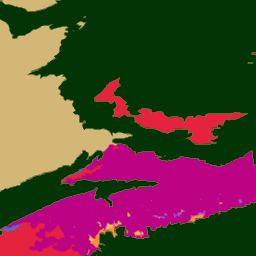
- Доступность набора данных
- 2023-09-14T00:00:00Z–2023-09-14T00:00:00Z
- Поставщик наборов данных
- Международный союз охраны природы и природных ресурсов
- Теги
Описание
Глобальная типология экосистем — это таксономия экосистем, основанная на их уникальных характеристиках. Это глобальная система классификации, обеспечивающая согласованную основу для описания и классификации экологических экосистем.
Глобальная типология экосистем включает шесть уровней. Три верхних уровня (области, функциональные биомы и функциональные группы экосистем) классифицируют экосистемы на основе их общих характеристик, таких как местоположение, доминирующий растительный мир и экологические процессы. Три нижних уровня (региональные подгруппы экосистем, глобальные типы экосистем и субглобальные типы экосистем) фокусируются на конкретных географических вариантах внутри функциональных групп экосистем и комплексов организмов, а также на связанной с ними физической среде, обеспечивая более детальное понимание конкретных экосистем.
Этот набор данных относится к третьему уровню глобальной типологии экосистем: функциональной группе экосистем. Она определяется как группа взаимосвязанных экосистем в пределах биома, имеющих общие экологические факторы, которые, в свою очередь, способствуют формированию схожих биотических черт, характеризующих эту группу. Типология формируется сверху вниз путем деления биомов на подгруппы.
ПРИМЕЧАНИЕ: Из-за размера некоторых геометрических фигур к каждой из них был применён алгоритм упрощения для снижения их сложности. Было отброшено максимально возможное количество вершин, не удаляясь от исходной фигуры более чем на 100 м. В результате около двух десятков строк в таблице превратились в геометрии с нулевой площадью и были удалены.
Схема таблицы
Схема таблицы
| Имя | Тип | Описание |
|---|---|---|
| efg_код | НИТЬ | Код функциональной группы экосистемы (например, «T1.1» = Тропические/субтропические низменные леса). Полную таксономию см. на сайте https://global-ecosystems.org/explore . |
| код_карты | НИТЬ | Код карты |
| версия_карты | НИТЬ | Версия карты |
| возникновение | ИНТ | Он указывает, содержит ли указанный регион основные (1) или второстепенные (2) появления функциональной группы. |
Условия эксплуатации
Условия эксплуатации
Наборы данных Global Ecosystem Typology предоставляются по лицензии CC BY 4.0, которая допускает повторное распространение и использование лицензированной работы при условии надлежащего указания автора.
Цитаты
Р. Т. Пеннингтон, Дж. Франклин, Н. А. Браммитт, А. Эттер, К. Р. Янг, Р. Т. Корлетт и Д. А. Кейт. (2022). T1.2 Тропические/субтропические сухие леса и заросли. В: Кит, Д. А., Феррер-Пари, Дж. Р., Николсон, Э. и др. (2022). Функциональная типология экосистем Земли — Приложение S4. Глобальная типология экосистем МСОП, версия 2.1: Описательные профили биомов и функциональных групп экосистем.
DOI
Исследуйте с Earth Engine
Редактор кода (JavaScript)
var ecosystemTypology = ee.FeatureCollection('IUCN/GlobalEcosystemTypology/current'); var propertyToFilter = 'efg_code'; var labelsAndColorsClient = { 'F1.1': '7e3fe6', 'F1.2': '77b3fd', 'F1.3': '7b8347', 'F1.4': 'fa6811', 'F1.5': '965e6e', 'F1.6': 'd595dc', 'F1.7': '2f14df', 'F2.1': '224730', 'F2.10': '2f6323', 'F2.2': 'ea36a3', 'F2.3': 'b2fc44', 'F2.4': 'c2318a', 'F2.5': '6f243e', 'F2.6': 'ad10a8', 'F2.7': '6a4210', 'F2.8': '839347', 'F2.9': '118b94', 'F3.1': 'cb3855', 'F3.2': 'd2b776', 'F3.3': 'ff72ed', 'F3.4': '377e85', 'F3.5': '3fa71f', 'FM1.1': '10e167', 'FM1.2': '4e6fca', 'FM1.3': '858536', 'M1.1': '141076', 'M1.10': 'a6067b', 'M1.2': '663dbc', 'M1.3': '850c23', 'M1.4': 'aa2923', 'M1.5': '937e3c', 'M1.6': 'f1ecae', 'M1.7': 'ba931f', 'M1.8': '023405', 'M1.9': 'ed5a09', 'M2.1': '354a2a', 'M2.2': '8239cf', 'M2.3': '73b3cc', 'M2.4': 'be48b2', 'M2.5': 'c4897c', 'M3.1': '68a571', 'M3.2': '69197d', 'M3.3': 'e22319', 'M3.4': '40b73a', 'M3.5': 'caf10c', 'M3.6': '762197', 'M3.7': '91b06a', 'M4.1': '91c173', 'M4.2': 'e1ea4a', 'MFT1.1': '9a1e2d', 'MFT1.2': '22aeda', 'MFT1.3': 'f0ae6e', 'MT1.1': '1b96de', 'MT1.2': 'ea9e91', 'MT1.3': '0c9494', 'MT1.4': '436836', 'MT2.1': '3478ff', 'MT2.2': 'e6233f', 'MT3.1': '0936c9', 'S1.1': '9d7488', 'S2.1': 'ea1bee', 'SF1.1': '231e5f', 'SF1.2': 'f4cc74', 'SF2.1': 'fb0986', 'SF2.2': 'fb9bce', 'SM1.1': '0d3303', 'SM1.2': '9964a5', 'SM1.3': 'f88d38', 'T1.1': '048045', 'T1.2': 'ac86c0', 'T1.4': '0e19a9', 'T2.1': 'bc0383', 'T2.2': '965eed', 'T2.3': '7d951f', 'T2.4': 'd98c15', 'T2.5': 'f1abff', 'T2.6': 'be7214', 'T3.1': 'b03750', 'T3.2': 'e74d19', 'T3.3': '696ec3', 'T3.4': 'fbb043', 'T4.1': '5b06be', 'T4.2': '583d4f', 'T4.3': 'edfc30', 'T4.4': 'f32748', 'T4.5': '363f08', 'T5.1': 'e6891c', 'T5.2': '032bc5', 'T5.3': '8daed3', 'T5.4': 'b359cb', 'T5.5': '8b5536', 'T6.1': '3d8857', 'T6.2': 'e87587', 'T6.3': '8336b8', 'T6.4': 'fa8a1b', 'T6.5': '7427f1', 'T7.1': '7d29a9', 'T7.2': '566e14', 'T7.3': 'f4bf4a', 'T7.4': 'fc2a94', 'T7.5': '0e6040', 'TF1.1': 'e0b4cc', 'TF1.2': '5aabbc', 'TF1.3': '63f039', 'TF1.4': 'ec6bdb', 'TF1.5': 'f786ec', 'TF1.6': '00b9f4', 'TF1.7': '77d71d', 'T1.3': 'ffffff' }; var labelsAndColors = ee.Dictionary(labelsAndColorsClient); var filteredEcosystems = ecosystemTypology.filter(ee.Filter.neq(propertyToFilter, null)); var image = filteredEcosystems .map(function (feature) { return feature.set('efgStyle', { 'color': labelsAndColors.get(feature.get('efg_code')), }); }) .style({ 'styleProperty': 'efgStyle', }); Map.addLayer(image, {}, 'Global Ecosystem Typlology'); Map.setCenter(-63.873, 46.194,8);
